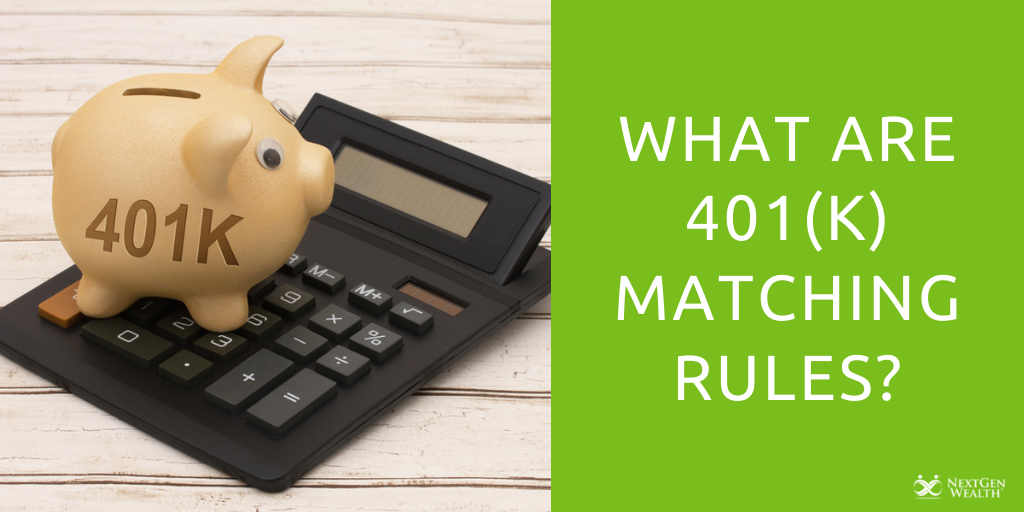What Are 401(k) Matching Rules?
The business world uses the term 401(k) often. Many employers offer their employees these retirement accounts as a benefit to working there. 
Some employers even offer 401(k) matching. This benefit is exactly as it sounds. An employer matches the amount of money that you contribute to your 401(k). So, you put money into your 401(k), and then your employer does the same.
It’s a great benefit for many people. It helps employers keep their most valuable employees.
With that said, let’s go over some basics about 401(k) matching, including some rules and generally how it works.
How Do 401(k) Matches Work?
Much like insurance plans, 401(k) plans are different depending on the employer. Generally speaking, there are two different types of matching plans.
There is partial matching and full matching (which is another name for dollar-for-dollar matching).
On average, employers match around 4.7 percent of an employee’s annual salary.
Depending on the type of matching plan, your employer places a certain percentage or amount into your 401(k). The different types of matching are exactly as they sound.
Partial Matching
This is when your employer places a partial amount into your 401(k). Meaning, they do not match it fully, but they do up to a certain percentage.
Commonly, employers will match about 50 percent of what you put in, up to six percent of your salary. This means that the employer will place three percent of your total salary into your 401(k) if you contribute 6%.
Most commonly, employers will match 50 cents to every dollar up to a certain point.
Full Matching
This simply means that your employer puts the same amount of money into your 401(k) that you do. However, much like partial matching, this is only up to a specific amount.
For example, if your employer’s maximum percentage is four percent, that means they will only put in four percent at the very maximum. If you put two percent in, they will two percent. If you put eight percent, they will only match it for four percent.
What Is the Limit?
For the year 2021, the IRS limit for personal maximum 401(k) contributions is $19,500–or $26,000 for those over 50 years of age.
However, there is no limit for employer contributions. The employer themselves typically decides what the maximum contribution is they will make, depending on whether it is a partial or full match. With either kind of 401(k) matching, employers will set a limit.
There is a limit to the contributions from both employer and employee. Combined contributions cannot exceed $58,000 or 100 percent of the employee’s annual salary, depending on what comes first. This is in reference to the 2021 tax year as well.
What Are Non-Discrimination Tests?
These tests make sure that employers pass the ACP or Actual Contribution Percentage test.
Essentially, this means an employer must make sure they are not exceeding contributions made to Highly Compensated Employees (HCEs) versus Non-Highly Compensated Employees (non-HCEs) by more than 125 percent.
The ADP test (Actual Deferral Percentage) also allows employers to test the same aspect in order to remain compliant with the IRS.
What is a Vesting Schedule?
This 401(k) matching rule offers employers some flexibility. It also allows employers to limit their loss if you do not end up staying with the company.
Essentially, this rule bases how much the employer matches your contributions to how long you have worked with them.
So, let’s say your employer contributions vest over five years. That means 20 percent of employer contributions belong to you after one year. Forty percent belongs to you after two years, 60 percent after 3 years, 80 percent after 4 years, and 100 percent after five years.
If you leave the company before five years, you risk losing some of that money. Employers use this as a method to keep employees on staff as well.
Cliff vesting is much more extreme. Think about it as if it is actually cliff diving. Once you jump off the cliff, it’s all or nothing.
With a five-year cliff, you will get none of the contributions until your fifth year. By your fifth year, you get 100 percent of the contributions.
What is a Safe Harbor Match?
A Safe Harbor 401(k) acts like a typical 401(k), but it ensures that all employers treat employees fairly and equally. Meaning, it will inherently pass any non-discrimination tests.
Because it is different from the typical 401(k), the matching rules and procedures also diverge. With a Safe Harbor 401(k), an employer must provide a match. There are two different Safe Harbor matches.
Safe Harbor Matching Contribution
The employer bases this match off of what the employee defers and puts into their own 401(k).
There is the basic match. This means an employer will match 100 percent of the first three percent compensation. Then they will match fifty percent on deferrals between about three to five percent, maxing at a total of four percent.
The enhanced match covers at least all of the basic matches. This formula typically looks like a 100 percent match on the first four percent compensation.
Safe Harbor Non-Elective Contribution
This contribution does not depend on the employee’s contribution.
The employer will match 3 percent or more on the employee’s salary. Even if the employee does not contribute to their 401(k), the employer still matches three percent.
What About a Roth 401(k)?
A Roth 401(k) has taxes taken out prior to contributions, making withdrawals tax-free Keep in mind, Roth 401(k)s are not offered by every employer.
Much like a traditional 401(k), these plans can have contributions from both employer and employee. However, because it is your income, your employer is not likely to pay taxes on their contributions.
Their match contributions will go into a traditional 401(k) account where taxes will come out when you make withdrawals in retirement.
What About the Self-Employed?
For those that are their own bosses, 401(k)s tend to play by different rules. 401(k) match rules tend to be different as well.
Because the self-employed are both employee and employer, the contribution limit is more. A self-employed person can contribute up to $58,000 for 2021 or 100% of their compensation, depending on which is less.
This number is also for those under 50 years of age. For those older, you can add an additional $6,500.
What About Small Businesses?
Some small businesses cannot afford to offer benefits like 401(k)s. If they do, some cannot afford to match as much as larger businesses can. Right now, only 25 percent of 401(k)s from small businesses match employee contributions.
It is important to remember that matching contributions are not required. They are just an added benefit or perk to employment. Many employers simply cannot afford to offer the benefit.
For those that do, they may have to wait to provide their contributions. Much like a vesting schedule, less than half of small businesses that do match require one year of employment before matching begins.
How Do Taxes Work?
Depending on your 401(k) plan, tax withdrawal occurs before or after investing.
Typically, you will pay taxes when you withdraw money from your 401(k). For Roth 401(k)s, the opposite is true. You pay taxes on your contributions, but you don’t pay any taxes on your withdrawals
If your employer offers 401(k) matching, it is important to understand what that entails. A 401(k) is a crucial step to saving for retirement. Although most employers can set some parameters of their matching, the basic rules are the same.
Whether your employer offers partial or full matching, you want to make sure you understand their rules. If you want one-on-one help from a financial advisor, contact NextGen Wealth today for a free financial assessment. We can help answer any questions you may have about your 401(k) matching rules.


